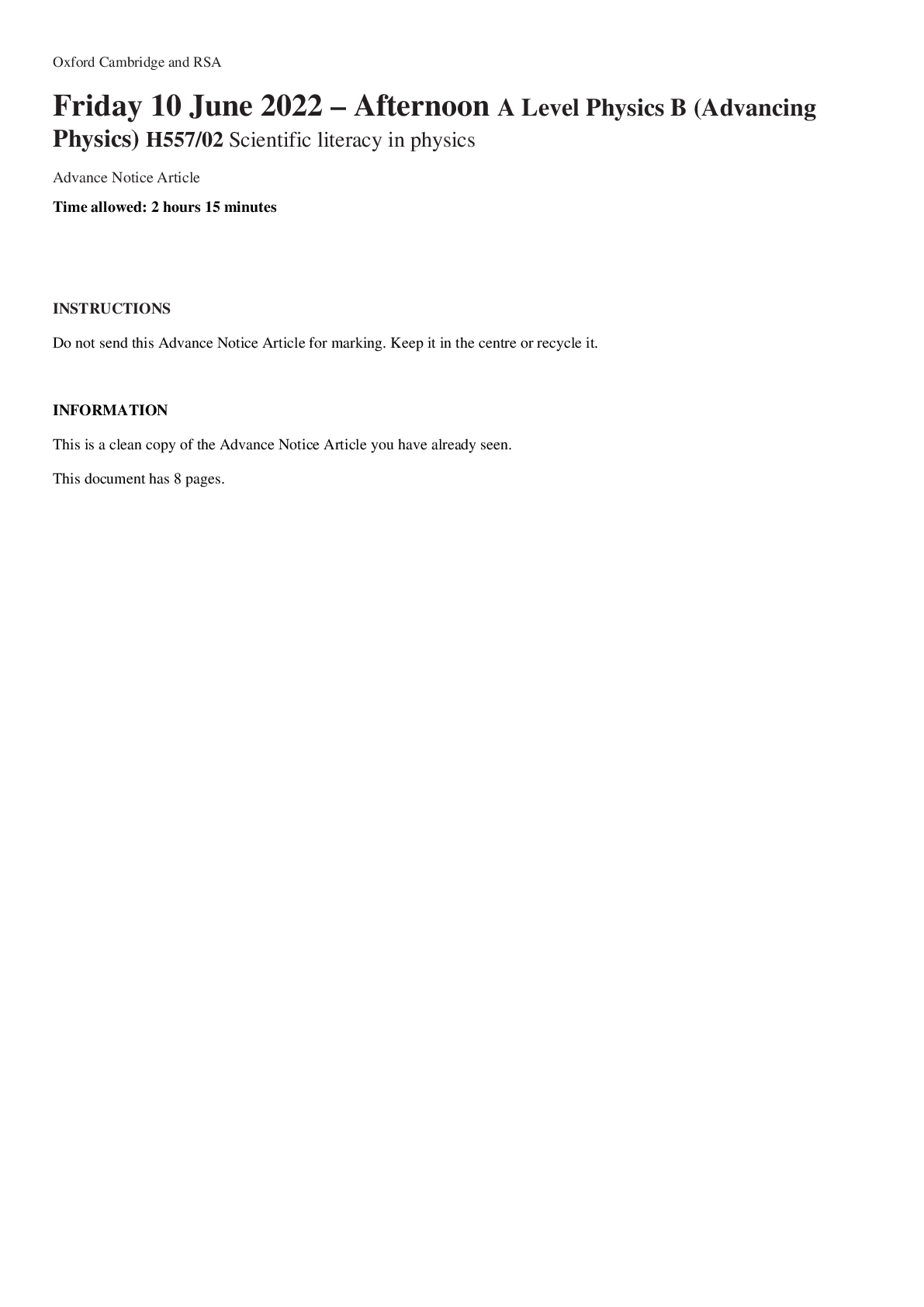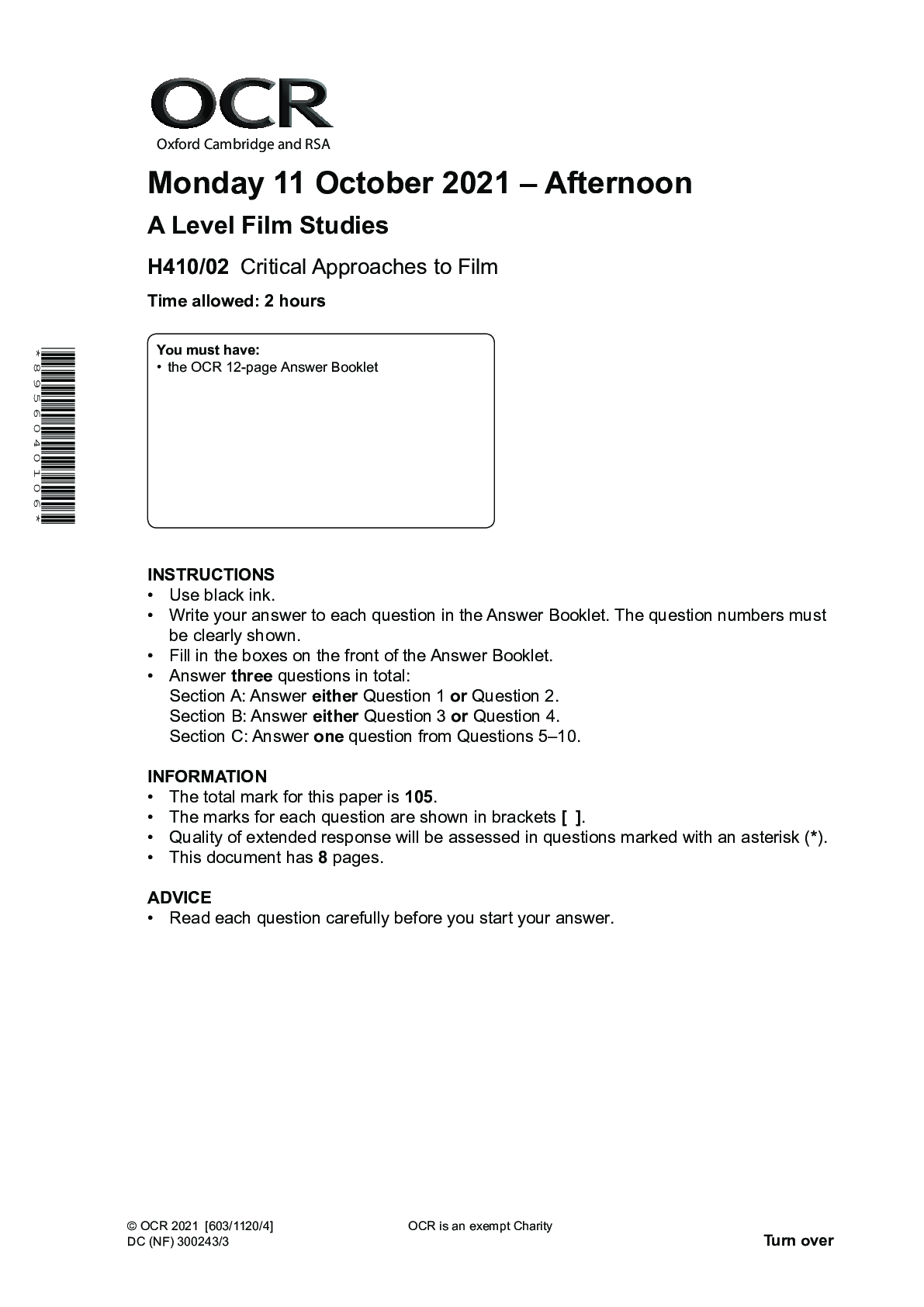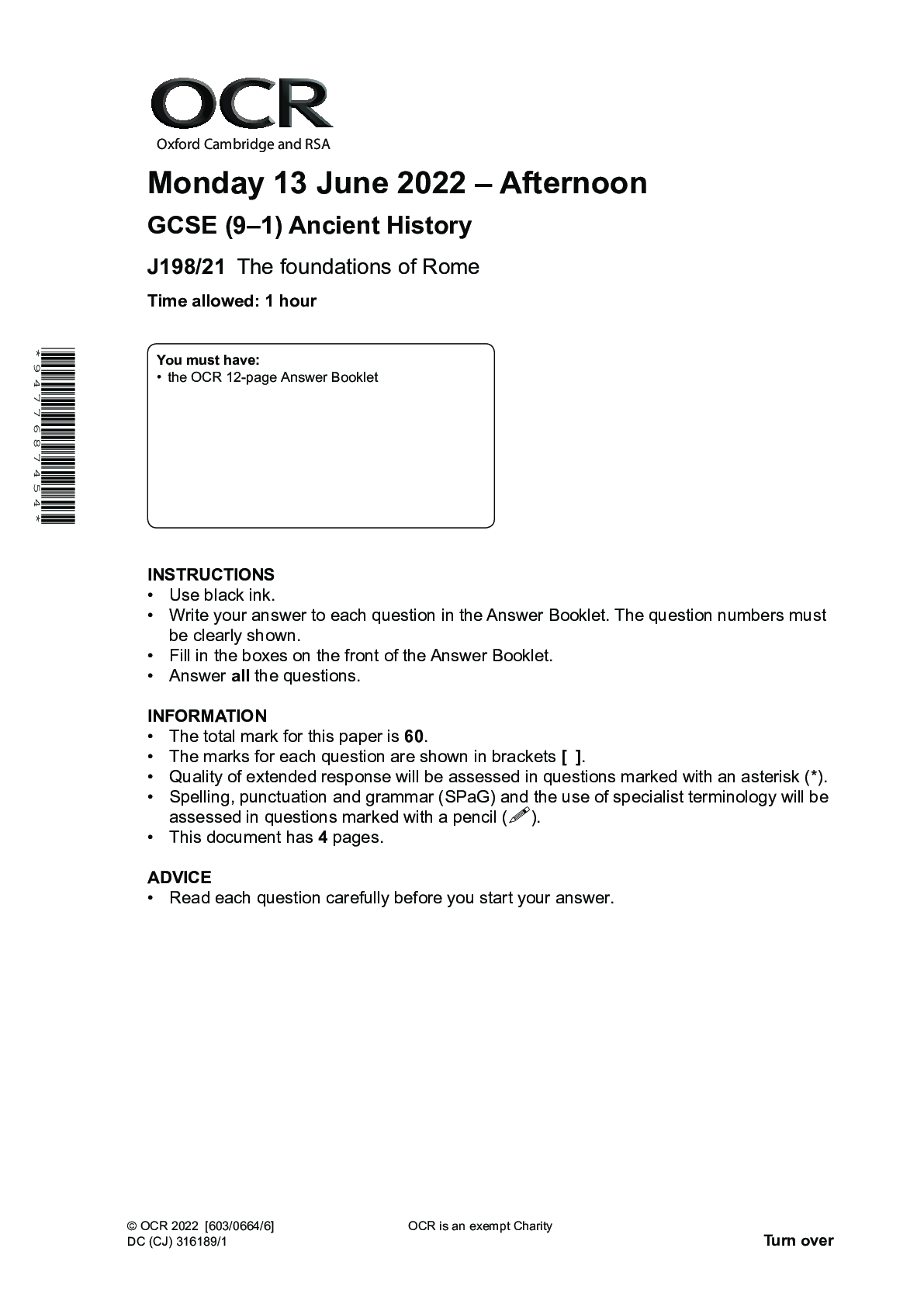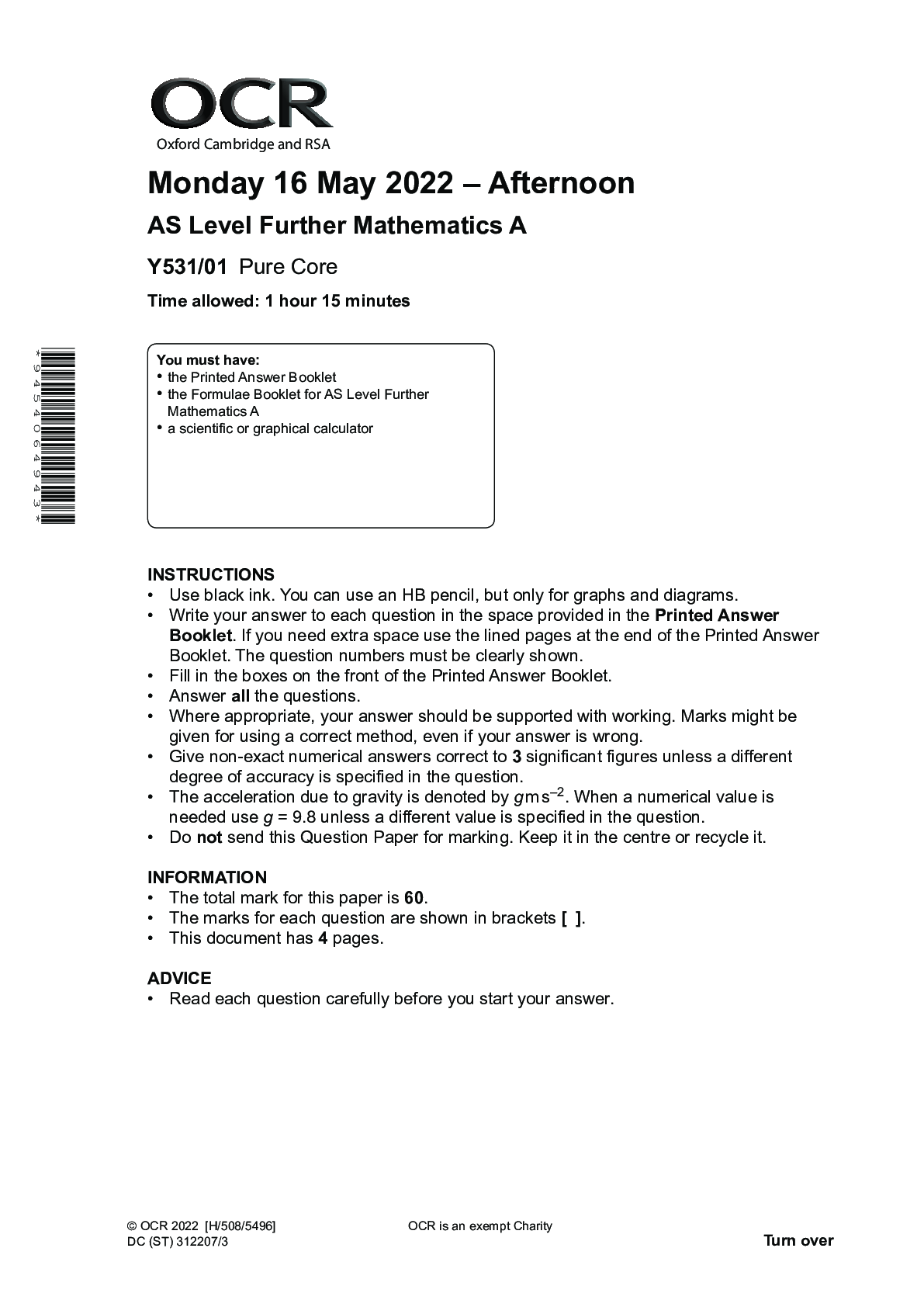Physics > QUESTION PAPER (QP) > Friday 10 June 2022 – Afternoon A Level Physics B (Advancing Physics) H557/02 Scientific literacy (All)
Friday 10 June 2022 – Afternoon A Level Physics B (Advancing Physics) H557/02 Scientific literacy in physics Advance Notice Article
Document Content and Description Below
Friday 10 June 2022 – Afternoon A Level Physics B (Advancing Physics) H557/02 Scientific literacy in physics Advance Notice Article Time allowed: 2 hours 15 minutes INSTRUCTIONS • Do ... not send this Advance Notice Article for marking. Keep it in the centre or recycle it. INFORMATION • This is a clean copy of the Advance Notice Article you have already seen. • This document has 8 pages. © OCR 2022 [601/4745/3] DC (RW/CT) 306525/3 OCR is an exempt Charity Turn over The new Icarus? In the Greek myth of Daedalus and Icarus, Daedalus makes sets of wings out of feathers and wax for himself and his son so that they can fly to escape their captors. Icarus ignores his father’s advice to keep near the ground and flies as high as he can. The heat from the Sun 5 melts the wax holding his wings together and the young man plummets to his death. The myth gives us a warning against over confidence – ‘don’t fly too close to the Sun’. But, for physicists and astronomers, one way to learn more about our nearest star is to fly as close to it as possible, but using more suitable materials than feathers and wax. The Sun emits electromagnetic radiation. It has produced a near‑constant radiant power of 10 4 × 1026 W for around 5 billion years and is only around half‑way through its supply of hydrogen fuel. At the Earth, the radiant power from the Sun is uniformly spread over the surface of a sphere of radius 1.5 × 1011 m – the Earth‑Sun distance. So, the power received from the Sun becomes a life‑supporting intensity of 1400 W m–2. Civilisations throughout history have recognised the supreme importance of the Sun to life on 15 Earth and it has been known for many years that the Sun drives the weather. In more recent times, other observations have been linked to the Sun, including the spectacular aurorae – the Northern and Southern Lights that sometimes hang like shimmering, shifting curtains of coloured light across the night sky at high latitudes. An image of such a display is shown in Fig. 1, but photographs scarcely capture the spectacle. 20 Fig. 1 The aurora borealis or Northern Lights seen from Tromsø in Norway. These wonderful phenomena are caused by the solar wind, a hail of charged particles (mostly protons and electrons) travelling at around 500 km s–1. These charged particles spiral down the magnetic field near the poles. This is because the component of their velocity perpendicular to the Earth’s magnetic field makes the charged particles orbit the field lines while the velocity 25 component parallel to the field is unaffected. The charged particles transfer energy to electrons in atoms in the atmosphere producing the spectacular lighting effects. These and other examples of ‘space weather’ can be very dramatic, damaging satellites, navigation systems and electrical transmission lines amongst much else. Space weather has become such an important topic that space probes have been sent tantalisingly close to the Sun to investigate its causes 30 and you can even get a space weather forecast from the Met Office. To consider how the Sun pushes out this stream of charged particles we must first think about the ultimate source of the Sun’s energy – the fusion of hydrogen in its core. The proton‑proton cycle Hydrogen is fused into helium in the Sun’s core (see Fig. 2) in a three‑stage process: 35 1H + 1H 2H + 0e + 0ν 1 1 1 +1 0 2H + 1H 3He + γ 1 1 2 3He + 3He 4He + 2 1H 2 2 2 1 corona chromosphere photosphere convective zone radiative zone core Fig. 2 Cross‑section of Sun, not to scale. Fusion requires extremely high temperatures to give the protons sufficient energy to overcome 40 electrostatic (Coulomb) repulsion. But even at the temperature of the core, the average energy of the protons is not enough to allow fusion. Of course, some protons will have energies far greater than the average but they still fall short of the energy needed for fusion. This provided a puzzle for physicists which was finally explained by a process known as quantum tunnelling. The low probability associated with these reactions means that the Sun is working through 45 its fuel at a slow and stable rate. This is important, if fusion reactions were more likely, and therefore more frequent, the fuel would be used more quickly and life on Earth would not have time to evolve. The structure of the Sun About 98% of the energy of the fusion reaction is taken away by gamma ray photons, the 50 remaining energy carried away by the neutrinos produced in the first stage of the process. The neutrinos reach the Earth in less than ten minutes whereas it takes the electromagnetic radiation about 100 000 years to make its way through the so‑called radiative zone of the Sun, a region of ions and free electrons called a plasma. During their journey through the radiative zone, the gamma ray photons are absorbed and re‑radiated by electrons in the plasma or 55 ionised fluid that makes up much of the Sun. This absorption and re‑radiation changes the direction (and energy) of the photons. Each photon’s path, a ‘random walk,’ is described by the equation d = x where d is the displacement of the photon from its starting point after n steps of length x. So the 60 total distance the photons travel is much greater than their displacement. As the name suggests, the region above the radiative zone transfers energy up to the surface by process of convection. The movement of charged particles throughout this region gives rise to the Sun’s complex and changing magnetic field. Above the convection zone the pressure and density reduce, allowing photons to travel far greater distances before interacting with particles. 65 This is the photosphere, the ‘surface’ of the Sun we see in visible light photographs. The colour of the Sun gives a clue to the temperature of the photosphere. The Sun radiates in all regions of the electromagnetic spectrum but gives out most visible light in the yellow region. From this we can make an estimate of the temperature of the photosphere using the relationship derived by the German physicist Wilhelm Wien in 1893: 1 70 λmax \ T This states that the peak wavelength λmax of the emitted electromagnetic radiation is inversely proportional to the kelvin temperature T of the object. This tells us, for instance, that the temperature of an electric toaster element glowing red hot is the same as the surface of a red giant star. 75 The chromosphere, lying above the photosphere, can be observed during total solar eclipses as a red region around the hidden Sun – the red colour coming from electrons moving between two specific energy levels in hydrogen. The solar wind emerges from the corona, the outer region of the Sun (see Fig. 3). This is a very low‑pressure region which emits changing patterns of electromagnetic radiation that show the 80 structure of the magnetic field guiding the movement of the particles that make up the corona. The temperature of the corona can reach above 2 million K. This gives the particles sufficient energy to emit X‑ray emissions that can be observed by spacecraft. One of the unresolved questions of solar physics is how the corona can be hotter than the lower layers which are closer to the energy‑producing core. 85 Fig. 3 The solar corona – the corona makes a pattern similar to that of a bar magnet with poles at roughly 1 o’clock and 7 o’clock. The Carrington Event On 1st September 1859 the British amateur astronomer Richard Carrington observed extremely bright streamers of light around a group of sunspots, dark regions on the face of the Sun. 90 This observation, independently noted by another astronomer, Richard Hodgson, was the first recording of a solar flare. These events are often associated with ‘coronal mass ejections’ or CMEs which, as the name suggests, eject matter from the corona into space. Solar flares are associated with rapid releases of plasma and ions with a typical total [Show More]
Last updated: 11 months ago
Preview 1 out of 12 pages

Reviews( 0 )
Document information
Connected school, study & course
About the document
Uploaded On
Jun 14, 2023
Number of pages
12
Written in
Additional information
This document has been written for:
Uploaded
Jun 14, 2023
Downloads
0
Views
42















 Y433-01 Modelling with Algorithms Wednesday 8 June 2022 – Afternoon.png)
 Y432-01 Statistics Minor Friday 17 June 2022 – Afternoon.png)


